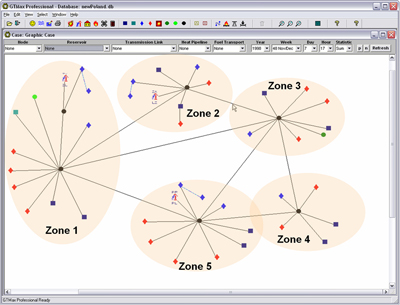| Center for Energy, Environmental, and Economic Systems Analysis (CEEESA) |  |
Research Areas:
Energy, Environment, and
Economics
National and Homeland
Security
Infrastructure Assurance
Emergency Preparedness
Social Dynamics
Policy Analysis
Core Capabilities:
Systems Analysis
Modeling, Simulation, and
Visualization
Complex Adaptive Systems
Decision Support and Risk
Management
Information Sciences
Economic and Financial Benefits of Distributed Generation Small-Scale Cogeneration in Poland
Methodology: The Center for Energy, Environmental, and Economic Systems Analysis (CEEESA) developed the Generation and Transmission Maximization (GTMax) model to study the complex marketing and operational issues in Poland’s deregulated energy markets. GTMax simulates the dispatch of generation units and the economic trade of energy among utility companies by using a network representation of the power grid. The objective of GTMax is to maximize the net revenues of power systems by finding solutions that increase income while minimizing expenses. The Polish power grid was modeled as a set of five interconnected power regions, or power pools, as shown below. CEEESA transferred GTMax to the Polish Energy Market Agency (EMA), trained a group of experts from the agency to use the model, and provided ongoing technical support to the team. By using GTMax’s powerful graphical user interface, EMA was able to quickly build a network representation of the Polish power system topology and analyze a variety of scenarios. Scope of Work: EMA staff used GTMax to track hourly energy transactions, the price of energy delivered to regional market hubs, and production costs. The model can be run for all 52 weeks in a year or for selected weeks. In this study, the model was run for the week with the highest hourly load (week 48) to estimate the costs and revenues associated with operating the CHP plants. The CHP plants were assumed to use reciprocating engines fueled by natural gas with an output of 24 MWe. The plants operate only during the heating season at times of high loads. The operation is regulated for heat on a seasonal basis, taking advantage of on-site heat storage capabilities. Because the CHP plants are expected to be located very near the load centers, transmission losses are negligible. The transmission system in GTMax includes all 400-kV and 220-kV power lines between the five regions as well as between Poland and the European grid (UCPTE). Under normal operating conditions, there are no transmission bottlenecks; however, some transmission paths are, at times, heavily loaded with economic bulk power transfers. Results of Analysis: Regional price differences are currently small (less than 5%) because the transmission network is not congested. The average projected market price for all five regions ranges from US$29.4/MWh on Sunday to almost US$50/MWh during late afternoon on three weekdays (see figure). The off-peak price is set by the marginal production cost for CHP plants in the central region; the on-peak price is set by marginal production costs of the pumped storage power plants. Because the northern region currently experiences negative reserve margins, model runs found that this region has the highest marginal value of energy and thereby is the most attractive for new CHP plants. Revenues and costs for the CHP plants were estimated for the peak load week. In the projected generation pattern, the units are generating electricity at full capacity for 14 hours per day (from 9 am to 10 pm). Revenues were calculated by multiplying the amount of energy sold by the hourly market clearing price. Incremental production costs are the cost difference between generating heat only and generating both heat and electricity. The short-term net revenues for the week were estimated to be US$86,000. Over the lifetime of the project, the net revenues must be enough to cover all fixed expenses and capital expenditures. An analysis of available hourly transfer capabilities for potential power transfers from Russia to Germany shows that capabilities are projected to be much larger along the central path, at times exceeding 2,000 MW. The northern path, on the other side, is often at or near its defined transmission transfer capability. Training and Capacity Building: As part of the project, CEEESA provided training in the in the GTMax model to several staff members of EMA. CEEESA has extensive expertise and experience in capacity building by assisting our model users around the world in form of training and implementation support. Over the last 25+ years, we have conducted training courses in many locations around the world and have successfully trained over 1300 experts from more than 90 countries in the use of our tools. Our models are actively in use in many of these countries. GTMax training courses and workshops can be tailored to your specific needs and can last anywhere between a few days to a couple of weeks. Courses may be held at Argonne's facility in the Chicago area or at your facilities. Click here for information on past and upcoming training courses. Additional Resources: For more information on this application and the GTMax model, download the following brochures, presentations, and papers in pdf format:,
For more information, contact CEEESA |
| U.S. Department of Energy Office of Science | UChicago Argonne LLC |
| Privacy & Security Notice | Contact Us | Search |




